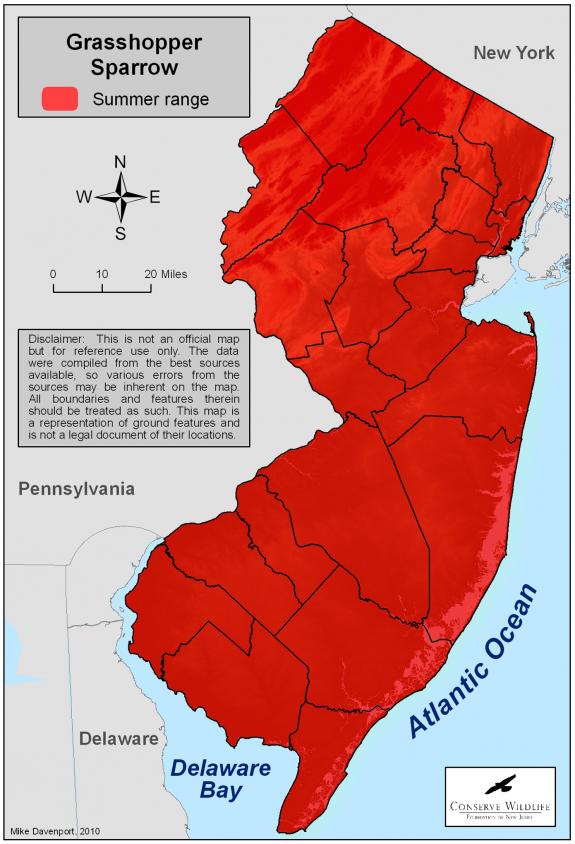Ammodramus savannarum
Type: bird
Status: threatened
Species Guide
Grasshopper sparrow
Ammodramus savannarum
Species Type: bird
Conservation Status: threatened
Identification
The grasshopper sparrow has a stocky body that is brown above with buff streaking. On adults, the breast and sides are solid buff and the belly is white. The buff breast and sides of juveniles are marked with dark brown vertical streaking. Grasshopper sparrows have flat heads with relatively large bills. The crown is dark brown with light central stripes atop the head and behind the eye. The lores (between the eyes and the bill) are orange or golden. The tail is short and brown.
A small, secretive songbird, the grasshopper sparrow is more often heard than seen. Its song consists of one to two chirps followed by a buzzy trill reminiscent of a grasshopper. This sparrow also sings a series of buzzy notes.

Distribution & Habitat
Grasshopper sparrows nest in open habitats throughout New Jersey. Controlled mowing schedules implemented for grassland birds at airports have enabled grasshopper sparrows to thrive at such sites. Historically, temporary habitat for grasshopper sparrows was inadvertently created when coastal wetlands were filled
Grasshopper sparrows breed in grassland, upland meadow, pasture, hay field, and old field habitats. Nesting grasshopper sparrows may occur on agricultural lands and airports where such habitats occur. Although grasshopper sparrows may use small grasslands, open areas over 40 hectares are favored. Optimal habitat for these sparrows contains short- to medium-height bunch grasses interspersed with patches of bare ground, a shallow litter layer, scattered forbs, and few shrubs. Clumped grasses, such as poverty grass and broom-sedge, provide cover and foraging areas and are consequently favored over sod or matting grasses. Shrubs, fence posts, and tall forbs are used as song perches.
Habitats may become unsuitable for nesting grasshopper sparrows if shrub cover becomes too dense. Consequently, presence and abundance varies annually as habitat changes. Habitat use during the nonbreeding season is similar, although less restrictive.
Diet
The diet of the grasshopper sparrow includes both animal and plant matter. During the spring and summer, they consume spiders, snails, and other invertebrates. Adult grasshopper sparrows feed caterpillars to their young. Grains, weed seeds, and grass seeds supplement the diet throughout the year.
Life Cycle
From mid-April to early May, grasshopper sparrows arrive at their breeding grounds. Males arrive prior to females and sing atop perches to establish their territory boundaries. Territory size averages 2-4 acres; however, the species may nest semicolonially at high-quality sites that offer habitat for numerous pairs.
The female constructs a nest at the base of a clump of grass in a shallow depression. The rim of the nest may be even with or slightly above the ground. Stems and grasses are woven together to form the nest, which is lined with finer grasses and rootlets. A clutch of four to five eggs is incubated by the female for 11 to 12 days. The female broods the newly hatched chicks, and both adults feed the young. Pathways leading to and from the nest enable the adults to land a distance away and run to the nest while concealed within ground cover. If disturbed, the adults may feign injury to distract predators away from the nest or chicks. After about nine days, the young leave the nest and hide in nearby vegetation. The parents continue to care for them for an additional one to two weeks. Grasshopper sparrows may lay two clutches of eggs during the same year, in which case the female builds a new nest for the second clutch. High levels of nest predation may necessitate the production of more than one clutch. Double-brooding extends the breeding season into early August.
Current Threats, Status, and Conservation
In New Jersey, the survival of grasshopper sparrows is linked with management practices for grassland birds on airports, agricultural lands, and pastures.
Habitat loss is the primary threat facing grasshopper sparrow populations in New Jersey. Many open areas that supported nesting pairs have been lost to development and vegetative succession. As a result, much of the remaining grasslands are small and fragmented. Fragmented habitats may not support breeding grasshopper sparrows. If nesting does occur birds are often vulnerable to elevated levels of nest predation.
Earlier and more frequent mowing, the use of crop species of limited habitat value, and the trend toward monocultures have negatively affected grasshopper sparrows. Frequent mowing, can destroy eggs and young or expose them to the elements and predators. The shift from warm-season native bunch grasses to cold-season matting grasses degrades habitat quality for nesting sparrows. Likewise, monocultures lack the habitat variety required by these birds. Areas that are intensively grazed may also be unsuitable for breeding, as excessive grazing can destroy the habitat and leave nests vulnerable to trampling.
As inhabitants of fallow fields and grasslands, grasshopper sparrows are dependent on active management to maintain open areas. Habitat management for grassland birds should be implemented on state and federal wildlife refuges, airports, and farmlands using incentive programs. Burning, mowing, or grazing can be used to suppress succession and remove shrubs and woody growth. Such management practices should be conducted after the nesting season is complete. Controlled burns should be carried out on a five- to seven-year rotation. Each year about 50% of habitat should be left unburned. Mowing can be performed annually, but only after chicks have fledged. At grassland restoration sites, warm-season native bunch grasses should be planted.
References
Text derived from the book, Endangered and Threatened Wildlife of New Jersey. 2003. Originally written by Sherry Liguori.
Scientific Classification
- Kingdom: Animalia
- Phylum: Chordata
- Class: Aves
- Order: Passeriformes
- Family: Emberizidae
- Genus: Ammodrammus
- Species: A. savannarum